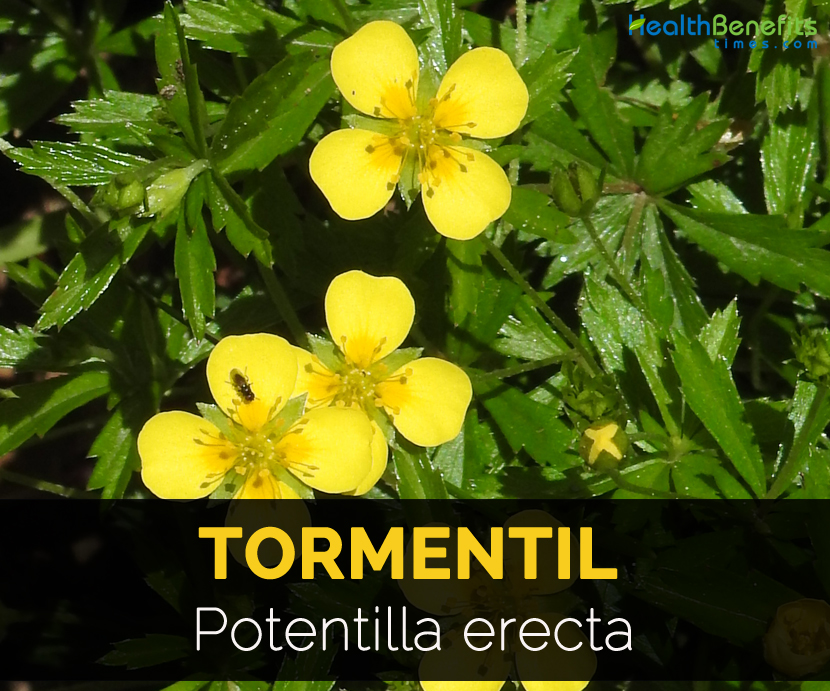| Tormentil Quick Facts | |
|---|---|
| Name: | Tormentil |
| Scientific Name: | Potentilla erecta |
Leaves on stalks are divided into three or five oval leaflets and toothed towards their tips. It is considered as the safe and most powerful of native aromatic astringents and for its tonic properties it is known as English sarsaparilla. All parts of plant acts as astringent especially red and woody rhizome. Externally it is brown or blackish, internally it is light brownish red. It is peculiar faint, slightly aromatic odor and strongly astringent taste.
Plant description
Tormentil is a small and rhizomatous plant which grows to the height of 1-1.5 inches on weak and slender stems and is primarily upright but occasionally procumbent. It is found throughout Eurasia in various environments including bogs, heaths, grasslands, alpine slopes and open woods. Leaves are in stem clinging rosettes consisting 3 to 5 glossy, lanceolate to wedge shaped leaflets.
Flower
Corolla is yellow, 1-1.5 cm broad and petals are four, shallowly notched, base with orange spots and 4-6 mm long slightly longer than sepals.
Leaves
Leaves are alternate, basal, long stalked. Stem leaves are virtually stalkless and stipulate. Blade is palmate with five leaflets. Leaflets are obovate and only tip with toothed margins, quite glabrous on top and underside densely short haired. Stipules are large and often lobed.
Uses
As a prompt botanical in purifying the system in diseases of the blood, and discharges of bloody flux. Administered either in a strong decoction, or the alcoholic extract. It is unrivalled in accumulation of excess mucus and the many progressive disease symptoms this condition brings on. To mention a few: the common cold, allergies, hay fever, tonsilitis, cholera, dysentery, haemorrhoids, etc. It is strongly astringent and will quickly relieve pain due to its influence in arresting the discharges and effectively diminishing unwanted accumulation. It is invariably successful in summer complaints of. children, even in cases where other means have failed.
Facts About Tormentil
| Name | Tormentil |
|---|---|
| Scientific Name | Potentilla erecta |
| Common/English Name | Various Leaved Fleabane, Pile Wort, Tormentil, Erect cinquefoil, Tormentil, Septfoil |
| Name in Other Languages | German: Blutwurz, Aufrechtes Fingerkraut, Blutstillendes Fingerkraut, Blutwurz, Gemeiner Tormentill, Tormentill, Aufrechtes Fingerkraut; Danish: Tormentil; Swedish: Blodrot; English: Bloodroot, Cinquefoil |
| Plant Growth Habit | Herbaceous perennial plant |
| Plant Size | 10-30 centimetres (3.9-11.8 in) tall |
| Medicinal parts | Root, herb |
| Flowering Season | May to August/September |
| Flower | Yellow, 7–11 millimetres (0.28–0.43 in) wide |
Dose
Steep 1 heaped teaspoonful of the root and herb in 1 cup of boiling water for ½ hr. Prompt relief will follow when taken hot in small amounts, often. Of the tincture, ½-1 ft. dram as called for.
Homoeopathic Clinical
Tincture of whole fresh plant—Diarrhoea, Gonorrhoea, Haemorrhage, Metrorrhagia, Orchitis.
Medicinal uses
- It is used in herbal medicine for treating dysentery, diarrhea, sore throats, irritable bowel syndrome, ulcerative colitis and colitis.
- The plant is used externally for cuts and wounds.
- The decoction is used as a wash for mouth ulcers, piles, infected gums and inflamed eyes.
- Use the extracts for chapping of anus and cracked nipples.
- It is helpful for bed wetting in children.
- Soak a piece of lint in decoction and apply it in warts.
- It is used to halt bleeding and smoothen skin.
- The extracts of tormentil root are used for dental and oral hygiene, treat mild inflammation of mouth and throat and denture sores.
- In folk medicine, add it to baths and compresses for treating poor healing of wounds, burns, frostbite and hemorrhoids.
- Use it internally for diarrhea and stomach problems.
Culinary uses
- Rhizomes are used to make tea.
- Roots are boiled for long and converted into gum.
Precautions
- Excessive use causes gastrointestinal symptoms.
- People with inflammatory and ulcerative bowel disease should avoid it.
- Pregnant and lactating women should avoid it.
References:
https://www.itis.gov/servlet/SingleRpt/SingleRpt?search_topic=TSN&search_value=504577#null
https://pfaf.org/user/Plant.aspx?LatinName=Potentilla+erecta
https://botanical.com/botanical/mgmh/t/tormen25.html
https://en.wikipedia.org/wiki/Potentilla_erecta
Comments
comments
